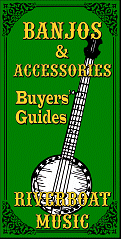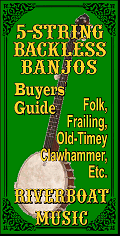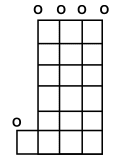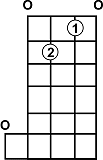Acoustic Instrument
Primers
What Kind of Guitar
Should I Start On?
What Kind of Banjo
Do I Want?
Evaluating and
Buying Used
Guitars
Setting Up
Fretted Instruments Whatever Happened
to the Banjo?
Beginning Five-
String Folk Banjo
6-String Banjos
Banjo Pickups
Axes in my Life
What is a
Bluegrass Banjo?
Dean "Backwoods
Six" Shootout
What is a Zither Banjo?
Music Theory
Primers
Introduction
to Scales
Introduction
to Chords
Circle of Fifths
Other Articles
About Music
How to Give
Guitar Lessons
Musician or
Wannabe? Did God Really
Give Rock &
Roll to You?
Are You a
"Brand Bigot"?
Who Owns Folk Songs?
Historical Links
About the
National Road
The Story Behind
the Story - Real
People, Places,
and Events
About the Play
Play Home
What's New
Overview
About the
Music
About the
History
About the
Logistics
About the
Cast
Synopsis
About the
Set
About the
Author
Contact Us
Home



|

|

Beginning Five-String Folk Banjo - Part One - Introduction to Banjo Chords
| Written by Paul Race for Creek Don't RiseTM and School Of The RockTM |
Although the banjo has been largely absent from pop music radio since 1980, groups like Mumford and Sons have reintroduced banjos to popular music. So friends who play guitar are suddenly interested in banjo. Not just Celtic banjo, which you can play on a number of instruments, but actual five-string banjos, which can do things you can't do on anything else.
The banjo may have been invented in Africa, but what we call "the banjo" came together in North America, and influenced every form of American music at some point or another, including not only Folk, Country, and Bluegrass, but also Jazz, Rock, and Classical.
The banjo also re-crossed the Atlantic in the late 1800s to be played like a classical guitar by "Zither Banjo" players, and to be adopted by several prominent Irish bands in the mid-1900s.
The most popular iteration of the banjo is the 5-string, which includes a high-pitched drone string that starts five frets higher than the other four strings and is seldom fretted. Sitting there at or near the top of the chord and ringing out a steady note for the whole song, the "fifth string" adds not only to the distinctive tone of the banjo, but also to the complications you run into when playing other keys.
Unfortunately that tone and those complications cause some folks today - including some amateur banjo players - to consider banjo fit for playing only certain kinds of music and only in certain keys.
This is a stereotype and a falsehood. Back when I was a kid in the 1950s and 1960s, folks used banjos for all kinds of music. And professional banjo players (yes they existed) were just as good at interpreting a wide range of keys, styles, and genres as their guitar-playing friends.
The 5-string banjo has been played many ways since, say, 1865, when these things started to be documented in any worthwhile sense. For well over a century, professional banjo players have picked whichever style suited the song and circumstances. And all currently popular banjo playing styles have their roots in the same pool of traditional approaches.
Starting out with traditional mainstream "Folk banjo" techniques is an excellent way to learn banjo in general and become acquainted with the fretboard and the most popular chords and picking patterns before you choose to focus one specific path or another. It also gives you the tools you need to take banjo back into multiple genres and keys, something that was once common but has been missing of late.
With the revival of interest in banjo, several of my musician friends have become curious about banjo in general. I've been explaining some things offline, and I figure it's time to post the same information online, too.
I'm especially interested in "jumpstarting" readers who are thinking about taking the plunge, but who are more interested in learning about banjo in general than in copying some particular picker's signature licks. If that makes sense to you, find a playable 5-string, get it in tune, and get started.
Note About Our MP3 Files - Once we get into a lesson, you'll see little MP3 icons that you can click on to play a file that is meant to give you some idea of how things should sound. On most browser, this will open a new window, but you can resume your lesson by going back to the old window. Yes, this is "primitive," but it's the only method that seems to work across most browsers. Our apologies in advance if it doesn't work so well on your favorite browser.
Here are the lessons we have online. Some are still being tweaked, and nearly every time I go into one, I see something that I need to fix, but at least it should get you started. I have listed the songs we use for examples in each chapter, in case you already have some background and just want to jump into the middle and try something. But each lesson builds on the previous lessons, so if you're starting from scratch, please don't jump right the lesson with a song you like and then get upset because it presupposes information you don't have yet.
Why "Folk Banjo" and Why Now?
Index of Lessons
When we started putting these tutorials together, we envisioned maybe ten lessons. Now we're up to twelve, and have at least two more in the being planned. Our goal is to use songs most people know to demonstrate basic principles that every beginning banjo player should understand. We also explain and define terms and concepts that you'll need to know sooner or later, if just to keep from looking stupid when someone mentions them later on.
| Lesson # and Topic(s) | Example Songs | |
| 1 - Introduction to Banjo Chords | "Buffalo Gals," "This Little Light of Mine," chords only | |
| 2 - Introduction to Banjo Rolls | "Buffalo Gals," "This Little Light of Mine," accompaniment only | |
| 3 - Hammering On | NA | |
| 4 - Introduction to Melody | "Boil That Cabbage Down," "This Little Light of Mine," banjo solo | |
| 5 - Pulling Off and More Melody | "Cripple Creek" chorus only, banjo solo | |
| 6 - Sliding and Sycopated Melody Lines | "Cripple Creek" verse, banjo solo, "This Little Light of Mine," advanced solo | |
| 7 - 3/4 Time and More about Chords | "Down in the Valley," accompaniment, banjo solo, advanced solo | |
| 8 - More 3/4 and More Chord Stuff | "Amazing Grace," accompaniment, solo, advanced accompaniment | |
| 9 - Standard (C) Tuning | "Go Tell Aunt Rhody," "Oh, Suzanna," accompaniment and solo | |
| 10 - Raised Fifth (DBGDa) Tuning | "Wreck of the Old 97," slow and double-time accompaniments and solos, "Boil That Cabbage Down" (in key of A), accompaniment and solo | |
| 11 - Other Keys and Tunings | NA | |
| 12 - Minor Keys | "Drill Ye Tarriers Drill" (Am), accompaniment and solo, "What Do You Do With a Drunken Sailor?" (Dm), accompaniment and solo | |
| 13 - Arpeggios and Celtic Styles | "Waggoner's Lad" (G), accompaniment, "Whiskey in the Jar" (D), accompaniment and solo | |
| 14 - Modal Songs | "Old Joe Clark" (G), accompaniment and solo, other key suggestions |
Parts of a Banjo
 The picture to the right is to get you acquainted with the major parts of a banjo, so if you're a complete newbie, the following sections will make more sense. The main thing to notice is that the banjo has two bits that can be called "head" (the peg head and the drum head) and that the body has many components, some of which have multiple names.
The picture to the right is to get you acquainted with the major parts of a banjo, so if you're a complete newbie, the following sections will make more sense. The main thing to notice is that the banjo has two bits that can be called "head" (the peg head and the drum head) and that the body has many components, some of which have multiple names.
Holding a Banjo
If you've never played guitar or mandolin, pay special attention to this note. The banjo body goes in your lap or, if your arms are short, off the right side of your leg. I personally prefer to wear a strap when playing banjos so I can position it in between. Actually I usually stand to play, which is always good practice for open mics, gigs, jams, etc. When I'm standing, the banjo body usually rests over my right pants pocket.The head of the banjo goes out past your left upper arm. When you reach your left hand up to play it, you put your thumb in the middle of the back of the neck and wrap your fingers around so they come almost straight down on the fingerboard.
5-String Banjo Tunings
Because the 5-string only has five strings, it can be retuned to "alternate tunings" quickly. And there are quite a few of those. That said, there are two primary tunings, and one - "Open G" - that is used predominantly in certain styles, including Bluegrass."Open G Tuning" allows you to play a G chord without fretting any strings at all. Like a guitar, the strings are numbered, with the first string being the farthest away from your chin. The fifth string is the short one that's closest to your chin.
The individual notes of the open strings are:
- First string - D above Middle C
- Second String - B below Middle C
- Third String - G below that
- Fourth String - D below that
- Fifth String - G above middle C
This is often abbreviated as "DBGDg tuning." For simplicity's sake, we'll stick with this tuning through the first few lessons.*
Note - When trained musicians spell out the tunings of string instruments, they give them with the string farthest from your chin first, usually in all caps. Most music teachers would indicate "G tuning" as DBGDG. That said, many internet forum contributors give their tunings "backwards," such a GDGBD. They come by that honestly, as many guitar players spell out their EBGDAE tunings backwards as well (EADGBD). But since the fifth string is unique, many banjo players reduce it to lower case, as in DBGDg, or gDGBD, depending on which direction they're going. We'll stick with the former convention through these lessons, but this way if you see the latter convention being used, you'll know what it means.
Reading Banjo Chord Charts
 Chord charts are little matrices that show where you should put your fingers to play different chords.
Chord charts are little matrices that show where you should put your fingers to play different chords.
Banjo chord charts usually have four vertical bars that represent the first four strings. The fifth string is often shown as a box attached near the bottom of the left side of the chart, to represent its physical placement.
In the chart to the right, the O's signify that you can play that string without fretting it. This shows a G chord in Open G tuning.
When a note needs to be fretted, little dots are placed on the fretboard where your fingertips should go.
 In the chart to the right, the dot with the 1 shows where you should put your index finger, and the dot with the 2 shows where you should put your middle finger. This is a D7sus4 chord, which is used a lot in G tuning.
In the chart to the right, the dot with the 1 shows where you should put your index finger, and the dot with the 2 shows where you should put your middle finger. This is a D7sus4 chord, which is used a lot in G tuning.
In smaller versions of the same chord chart, the dots are just little black circles, since most banjo players can figure out which finger goes where.
If you're not already used to guitar or mandolin, practice using your index finger to push down on the 2nd string where the chord chart shows. Don't put your finger right on the fret - that will deaden the strings. Instead, push down so that you force the string against the first fret. When you pluck that string with your right hand, it should ring freely.
Now practice putting your second finger where the little circle with the 2 shows. Once you force the string down against the fret, it should ring clearly when you pluck it.
Now do them both at once. Chances are really good that you can't hear the second string at all because the soft part of your middle finger is deadening it. That's why you have to bring your fingers almost straight down. Practice playing the cord until all strings ring freely.
As an experiment, I've added a short You-Tube that supplements some of the discussion on this page. You still need to learn the stuff written here, though, sorry.
If you do go to the You-Tube site, please add a comment, so I know whether you find this sort of thing useful or not. Thanks.
For the moment, just strum the strings slowly with your right hand so you can make certain you're hearing all the notes clearly. To help you practice going back and forth between G and D7sus4, here are the words to a tune you should know, with the name of the chords written in where you should change.
- G
Buffalo Gals, won't you come out tonight.
D7sus4 G
Come out tonight, Come out tonight.
G
Buffalo Gals, won't you come out tonight,
D7sus4 G
And dance by the light of the moon.

If it would help you to see sheet music for this, click here. If it would help you to hear the melody with the strummed chords, click here.
One other figure that you'll see on chord charts is a little X that shows you NOT to play a string. The chart to the right shows a "normal" D chord. The little X over the fifth string shows that you don't play that string, because the note it produces clashes with the note you're playing on the first string. Practice playing the chord with and without playing the fifth string, and you'll see what I meant. 
Now forget you ever learned this chord for a few weeks. You'll come back to it eventually, but for now, if you're playing a song in the key of G, and the music says to go to D or D7, substitute the D7sus4 chord we already showed you. Isn't that easier?
 Speaking of the key of G, there's one other chord you'll use all the time in that key - a C chord. In G tuning, this is played the way the drawing shows at the right, with three fingers.
Speaking of the key of G, there's one other chord you'll use all the time in that key - a C chord. In G tuning, this is played the way the drawing shows at the right, with three fingers. 
You'll learn lots of other chords eventually, but you'd be surprised how many hundreds of songs you can play with just these three chords. For now, just stumming with your right hand, practice changing these chords to this little ditty.
G
This little light of mine, I'm going to make it shine.
C G
This little light of mine, I'm going to make it shine.
G
This little light of mine I'm gong to make it shine.
G D7sus4 G
Make it shine, make it shine, all the time.
If it would help you to see sheet music for this, click here. If it would help you to hear the melody with the strummed chords, click here.
About Pain
By now, your fingertips probably hurt. Good; that means you're doing it right. If you can practice at least twenty minutes a day, you'll build up a nice set of callouses, usually within 10-14 days.
If you're not "under the gun," try not to practice so long at first so that you get blisters - then you have to hold off for a day or so while they heal and you'll lose more time in the long run.
On the other hand, if you leave the thing back in the case for several weeks at a time, you'll have to start building up callouses all over again. So 20 or more minutes of daily practice is a good plan. If you can't do it any other time, do it while you're watching so-called reality television or something. By the way, if you already play guitar, you may be surprised to notice that your fingers hurt in new places. This is because your fingers hit certain strings at slightly different angles than they do on your guitar. You're ahead of folks who've never played a stringed instruments, but you're not home free.
Conclusion
This is actually a little more than you'd get in your average first lesson, so I hope you don't feel disappointed that you haven't got a tiny bit further along yet. The next section focuses on right-hand techniques and will get you sounding a little more like a banjo player. In the meantime, work on changing those chords. Back and forth, back and forth.And contact us if you're hitting any brick walls. :-)
Best of luck, all, enjoy your music, and support the arts.
Paul Race
And when you're ready to move on, click here to go to our second online lesson.
*The other most common tuning is DGBCG tuning. In this tuning, the fourth string is tuned down to a C, but the rest of the notes are the same.
Another common ajustment is to tune the fifth string to other notes for playing in other keys. For example, if you need to play in D or A, you would typically tune the fifth string a step higher to A, so it fits in with the chords you're playing. But constantly retuning the fifth string can cause it to grow crazy and old before its time. Banjo players who gig a lot with other musicians who play in many different keys often do "mods" to their banjo to allow changing the pitch of the G string without constantly retuning it. (We don't have time to go into this now, and we don't recommend doing this at home, but the most common mod is called "spiking," if you want to look it up.)

All material, illustrations, and content of this web site is copyrighted ? 2001, 2002, 2003, 2004, 2005, 2006,
2007, 2008, 2009, 2010, 2011, 2012, 2013, 2014, 2015 by Paul D. Race. All rights reserved.
Creek Dont' Rise(tm) is a participant in the Amazon Services LLC Associates Program, an affiliate advertising
program designed to provide a means for sites to earn advertising fees by advertising and linking to Amazon.com.
For questions, comments, suggestions, trouble reports, etc. about this play or about this web page, please contact us.
| Visit related pages and affiliated sites: | ||||||
| - Music - | ||||||

|
 |
 |

|

|

|
|

|

|

|

|

|

|
|

|

|

|

|

|

|
|
| - Trains and Hobbies - | ||||||
 |

|

|  |
 |

|
|
| - Christmas Memories and Collectibles - | ||||||
 |

|
 |

|
 |

|
|
| - Family Activities and Crafts - | ||||||
 |

|

|

|

|

|
|
